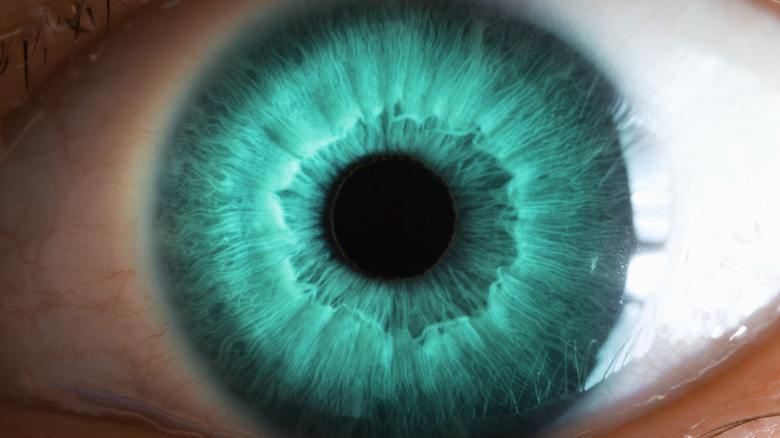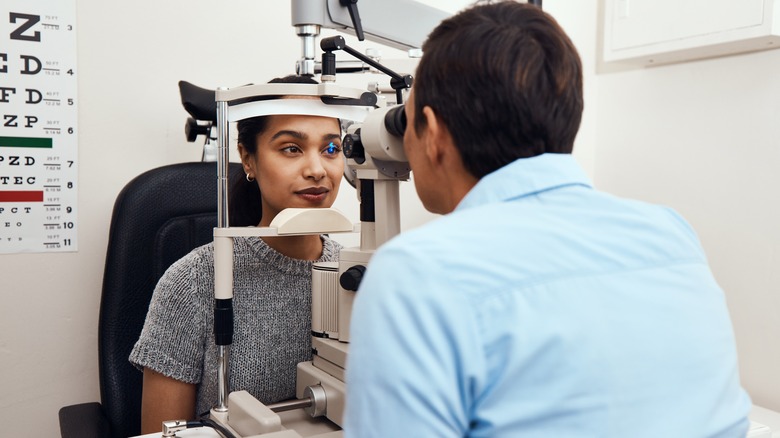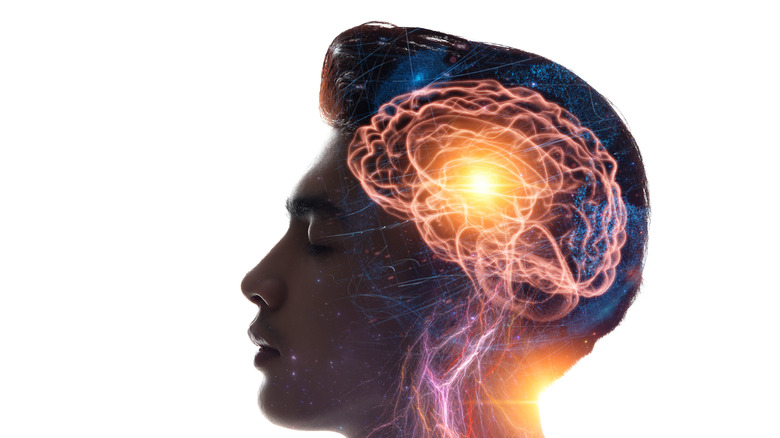What Would Happen If Humans Had Three Eyes?
Evolution may have given Homo sapiens two eyes, but over the millennia, philosophers, mystics, and clerics have longed for the development of a third. In this case, the longing is not for a third, physical eye — no amount of prayer or meditation is going to change evolution — but a spiritual one. For example, an article on Learn Religions provides a meditative process to "unblock" your "third eye," which will help you identify and let go of emotional baggage — and possibly battle flu symptoms.
In the natural world, rare is the animal that has more than two eyes, save for insects, which can have hundreds. A handful of reptiles have what's called a parietal eye, which is something of a third eye and is a vestige of their own evolution (via ScienceDirect). But what if evolution had provided us with three eyes? Would our lives be appreciably better? Would we have supervision that would enable us to see through walls? The What If Show took a look (no pun intended) at the idea and concluded that we wouldn't actually be much better off with an extra eye.
Human Vision Is Pretty Good, Comparatively Speaking
Before diving too deeply into trying to understand what it would be like if humans had three eyes, let's first take a look at how well we do with the two we already have. And as it turns out, human vision is a bit of a mixed bag when compared with the rest of the animal kingdom.
As EarthSky notes, asking, say, a dog to take a vision test is a bit out of the question. Instead, researchers compiled notes based on observations of various animals' behavior and the anatomy of their eyes and came up with a way of measuring visual acuity: cycles per degree. We'll spare you what that means on a physiological level and instead tell you what it means on a practical level. And that is, animals with higher cycles-per-degree vision have better visual acuity (or sharpness). Some birds of prey, such as eagles, have cycles in the thousands, enabling them to see tiny mice scurrying through the grass as the birds fly hundreds of feet ahead. Humans (and chimpanzees and other primates) can discern about 60 cycles per degree, dogs and cats about eight to 15 (per EarthSky).
Of course, there's more to vision than just visual acuity. There's low-light vision (cats have got us beat there, according to pet-food manufacturer Hills), depth perception, the ability to discern colors, and a host of other factors. In fact, color vision in humans is its own can of worms.
But There's More
You may have heard at some point in your life that your dog is color-blind. That doesn't mean that he only sees in black and white; rather, it means that he has difficulty differentiating between certain colors. As Hills explains, that's because they only have two cones in their eyes, cones being the ocular organ that helps discern color. According to Healthline, humans typically have three (trichromacy), except for the very, very few who have four (tetrachromacy).
Tetrachromats — who are almost exclusively women, for complicated reasons having to do with genetics — can see literally tens of millions of colors, as opposed to the million or so that the rest of us can see. Of course, being a tetrachromat confers little to no evolutionary advantage. Some tetrachromatic species of birds, for example, utilize this aspect of their vision in finding a mate, and some species of insects use it to differentiate between flowers. But for us humans, it means little to nothing since we've gotten by for 200,000 years without it.
Taxing The Brain
As the National Eye Institute explains, your eyes don't "see" anything; rather, they collect light signals and transmit them to the brain, which interprets those signals as vision. The same is true with your other senses as well: your nose doesn't smell, your ears don't hear, etc. They just send information to the brain.
The brain, for its part, needs to prioritize all of that information and weed out what it doesn't need (per Quanta Magazine). That's why you'll generally notice something scurrying about in the grass: because the grass moving means that either a predator or prey is nearby, and the brain, with a first priority of keeping you alive, is going to make sure that you're aware. On the other hand, if you work in a place with a distinctive smell, after a while, you're just not going to notice it anymore because the brain is focused on new things — not routine things — because new things need attention.
This is important because if we had a third eye, it would be giving one-third more visual stimulus to the brain and thus would require the brain to sort out one-third more of the visual stimulus it receives.
A Third Eye Isn't Likely To Do Much
Based on what we know about how the human eyes and human brain work, The What If Show took a look at the data and concluded that a third eye isn't going to really make much difference. "Most likely, your third eye would only be good for detecting light and movement, but not much else," the researchers concluded. And for whatever it's worth, that's effectively the same thing that the vestigial parietal eye in some reptiles does. The third eye could theoretically give us an extra layer of protection for detecting threats, but evolution has provided us with ears that do the same job admirably well. And when all else fails, there's the fact that we humans are social critters, and our social groups help protect us from danger as much as our own individual senses do.
There's also the matter of where the third eye would go. Space in the head is limited, taken up mostly by the brain, and so a third eye socket is likely to take up space that would otherwise be occupied by the brain. A third eye on our face isn't likely to tell us anything our other two don't already tell us; one on the top of the head would be useless since there's nothing directly above our heads that's of any interest to us (birds don't prey on us), and if it were on the back of the head, it would be obscured by hair.
There Have Been Three-Eyed Humans (Kind Of)
There has been at least one well-documented case in human history of a living human being having been born with three eyes. However, in that particular case, calling the baby "three-eyed" is a bit misleading.
As the West African Journal of Radiology reports, some time before 2018, a baby was born with three eyes. However, he wasn't an otherwise-normal infant who just happened to be born with a third eye; rather, he was born with craniofacial duplication, or diprosopus — a genetic condition in which the face appears to be duplicated on the head. It's related to the same biological process that results in conjoined twins. So in this sense, the lad wasn't born so much with a third eye as he was born with a second face that seemed to only include an eye. Most children born with craniofacial duplication are stillborn, but a few do survive. Even so, the journal notes that children are rarely born with a third eye "with almost all of its components," as the journal states. However, the journal does state that it has happened a few times since we've been recording these things in the medical literature.
As for the African baby, researchers noted that his third eye was hazy but that all three sets of eyelids blinked at the same time.





